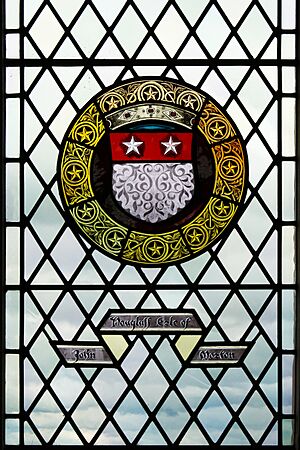James Douglas, 1st Earl of Morton facts for kids
Quick facts for kids James Douglas |
|
|---|---|
| 1st Earl of Morton | |
|
|
|
| Reign | 1456 - 22 October 1493 |
| Predecessor | James Douglas, 2nd Lord of Dalkeith |
| Successor | John Douglas, 2nd Earl of Morton |
| Spouse(s) | Joan Stewart, Countess of Morton |
| Issue | |
| John Douglas, 2nd Earl of Morton James Janet, Countess of Bothwell Elizabeth |
|
| Noble family | Douglas |
| Father | James Douglas, 2nd Lord of Dalkeith |
| Mother | Elizabeth Gifford |
| Born | 1426 |
| Died | 22 October 1493 |
James Douglas (born 1426, died 22 October 1493) was an important Scottish nobleman. He was the 4th Lord of Dalkeith before becoming the 1st Earl of Morton in 1458. This was a very important title in Scotland.
Contents
Life of James Douglas
Early Life and Becoming an Earl
James Douglas was the son of James Douglas, 2nd Lord of Dalkeith. His mother was Elizabeth Gifford. In 1456, James's father gave him all his lands. This made James the 4th Lord of Dalkeith.
Two years later, in 1458, James became the Earl of Morton. This happened when he married Joan Stewart. Joan (1428-1493) was the daughter of King James I of Scotland. She was unable to hear or speak.
Political Connections and Challenges
The Earl of Morton made an agreement with Patrick Graham, who was the Bishop of St. Andrews. This agreement was about the Bishop's niece marrying John Douglas, who was the Earl's oldest son and heir.
In return, the Grahams (the Bishop, his brother, and nephew) promised to help the Earl. They said they would help him get back lands that had been taken from him, like Whittingehame and Morton.
However, it seems this promise was a trick. It was meant to pull the Earl of Morton into a secret plan. This plan involved the Bishop, Lord Boyd, and his group. Robert Boyd, 1st Lord Boyd was one of the people ruling Scotland while James III of Scotland was still a child. Lord Boyd took control of the young king and arranged for his own son to marry the king's older sister. For these actions, Lord Boyd was later accused of serious crimes against the king.
It appears the Earl of Morton did not join this secret plan. In fact, he was part of the group that decided Lord Boyd and his family were guilty. Bishop Graham was later removed from his church position.
Expanding His Lands and Legacy
Between 1473 and 1474, the Earl gained control of the lands of Whittinghame. He also got back all rights over the area of Morton in Dumfriesshire. In the same year, he got back the lordship of Dalkeith. This made the Earl's land holdings even larger.
He also supported the church. He gave more money and resources to the church in Dalkeith, which his great-great-grandfather had started. In 1474, he also founded St. Martha's Hospital in Aberdour.
The Earl of Morton passed away on 22 October 1493. His son, John, then became the 2nd Earl of Morton. His wife, Joan, had passed away four months earlier, on 22 June 1493.
The Morton Monument
The Earl and Countess of Morton were buried together. Their tombs are in the main part of the parish church of St. Nicholas Buccleuch. This church is also known as the Dalkeith Collegiate Church. It is located in Dalkeith, Scotland, south of Fife and east of Edinburgh.
Their tombs are covered with stone statues, called effigies, that look like them. These statues also show their family symbols. Today, the part of the church where they are buried is in ruins. This means their tombs are out in the open.
Over many centuries, the weather has worn away their faces. Their hands, which were once pressed together in prayer, were likely destroyed during a time of big changes in the church called the Reformation.
One visitor described the tombs as looking like "sand sculptures after the tide has washed in and retreated." Even though they are worn, these tombs are very important historically. In 2005, a group of volunteers and people who work to save old buildings created a protective cover over the statues.
Family
James Douglas and his wife Joan had the following children:
- Sir John Douglas, 2nd Earl of Morton.
- James, who was mentioned in official papers between 1466 and 1480.
- Janet, who married Sir Patrick Hepburn, 1st Earl of Bothwell before 1 February 1490.
- Elizabeth, who was mentioned in a special document from 1479.



